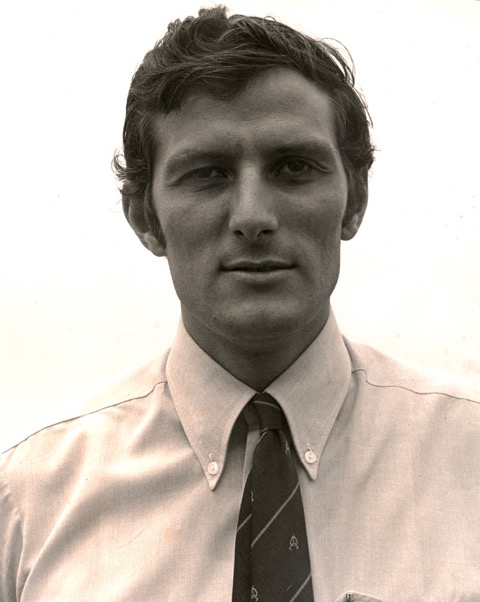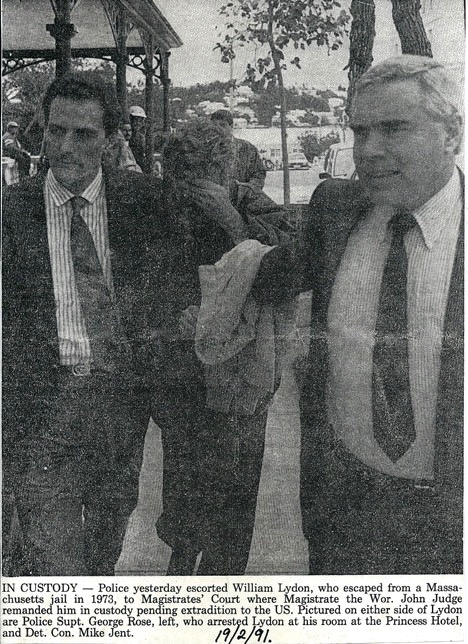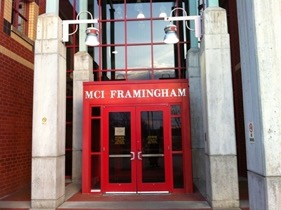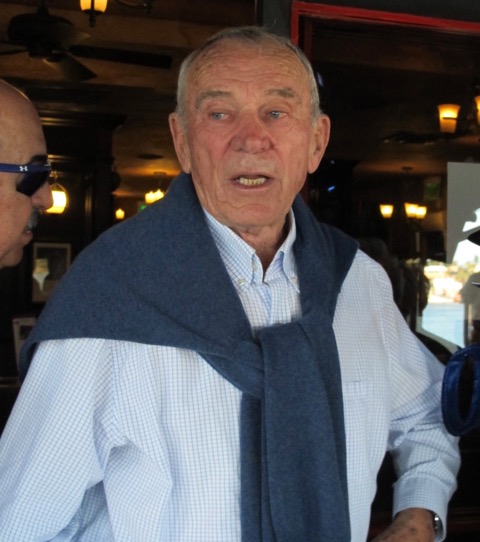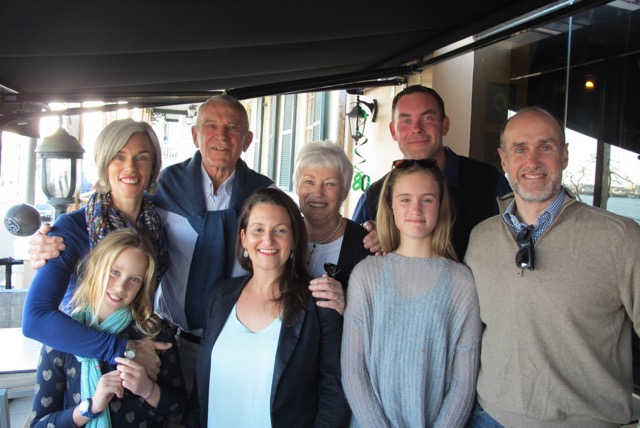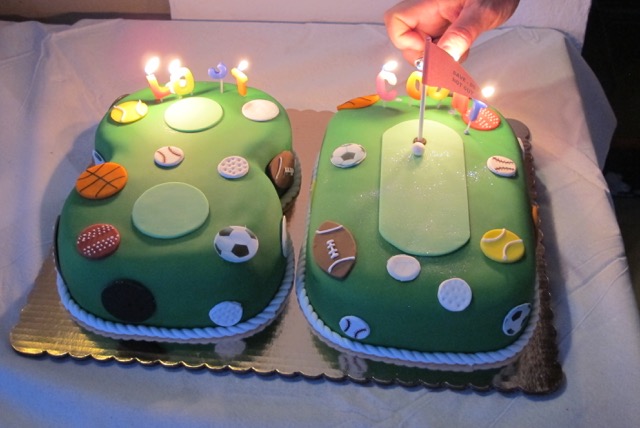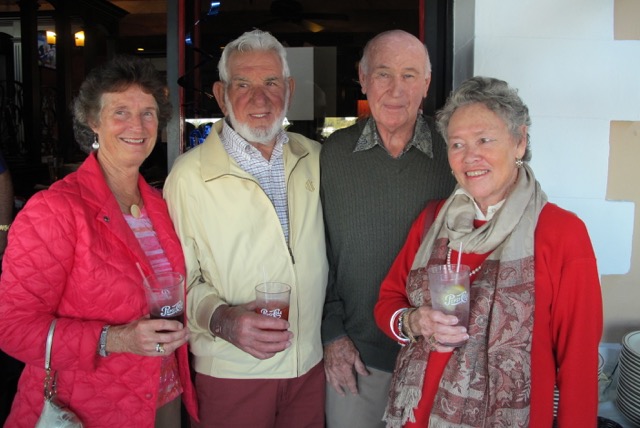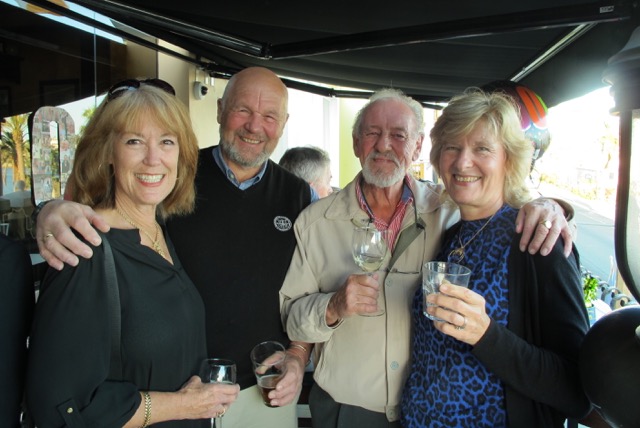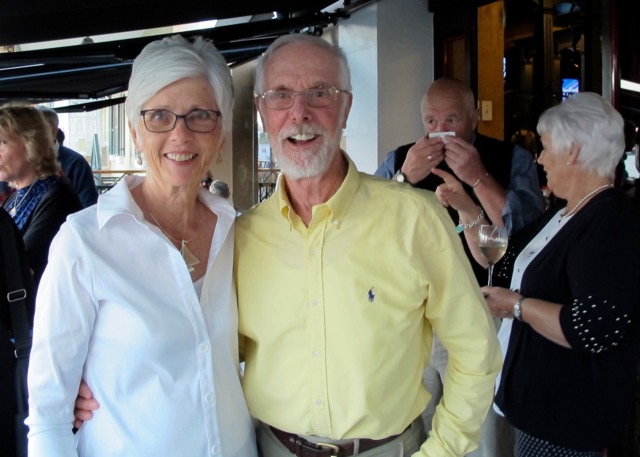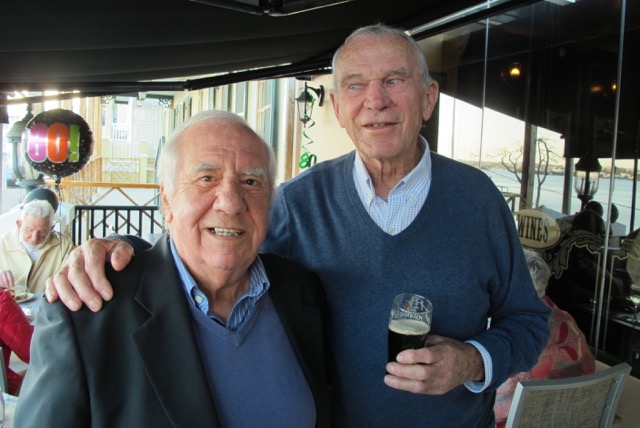Kindly submitted by retired
Superintendent George Rose
George Rose
Editors note - The following article has been expanded from one previously published on our website to now include two brothers and fellow Bermuda Police officers - Murdoch and Fergus Ferguson
When browsing recently through documents in my possession I came across a four page pamphlet described as a ‘Supplement 1989’ inserted inside the 110th Anniversary Issue of the October 1989 Bermuda Police Magazine. On the colourful front cover of the magazine under the words “IMAGES PAST AND PRESENT” could be seen a photographic representation of “our two latest recruits, W.P.C. Shacolbi Smith and P.C. Calon Hollis, with one of our first constables, Thomas J. Powell. Constable Powell was depicted in full winter uniform with the letters HPC clearly depicted on the forward collar of his tunic along with a trio of medals on his left breast. Three stripes can be seen ringing his lower left sleeve above the wrist. The photo is credited to D/Sgt. Howard Cutts and is clearly a copy of the original photograph.
The four page Supplement insert carried inside of it *IN MEMORIUM* the obituaries of the following four officers:
Serving Constable George Howard Kirkham (1945 – 1989); Retired Chief Superintendent Oliver Salsbury W. Trott, QPM CPM (1914 – 1989); Retired Detective Constable Earl Sinclair Hazel (1915 – 1989) and Retired Police Constable Murdoch Ferguson (1903 – 1989).

“Pc Murdoch Ferguson (retired) 1903 – 1989
Murdoch Ferguson who died on August 28th 1989 in his native Scotland was one of the Bermuda Police’s
oldest pensioners. Murdoch was born in Benbecula, Outer Hebrides, one of the remotest parts of the
British Isles, and was a farm worker prior to joining the Bermuda Police in 1935. The references he received
from his parish priest, headmaster and solicitor testified to his strength of character and obliging nature.
Murdoch’s entire career was spent in Central Division where he worked for many years as the Paget District
Constable. He was described as a “firm, straight forward Police Officer with an eye to detail and of quiet
disposition.” Murdoch Ferguson retired from the Bermuda Police in 1958, and was employed at Bellevue,
Paget. He made his home on Bostock Hill. Murdoch served Bermuda faithfully and deepest condolences
are extended to his family”. Author: Unknown.
Since my own Celtic bloodline heritage is that from the Scottish Highlands (with a 3 x Great Grandfather born in Ardclach, Nairnshire in 1779), I decided to research Murdoch’s history in an attempt to determine how and why he had entered into the service of the Bermuda Police in 1935. It seemed to me that he was a character worthy of my time and research effort in an attempt to answer these fundamental questions. He originated from ‘one of the remotest parts of the British Isles’ and his upbringing must have been tough and solitary. I was intrigued to learn by what manner of circumstance he had found himself resident on another such isolated island as Bermuda. Who or what was the magnet that drew Murdoch to Bermuda? Who was his Island contact and by what means did he travel here? Clearly, travel to Bermuda in those pre-war days was long and difficult and just didn’t occur by happenstance.
BENBECULA, OUTER HEBRIDES
The 1911 Census produced an early lead and showed Murdoch aged 8 years, AND it also showed him with an older brother by the name of Fergus then aged 10 years.
1911 Census: at Hacklet, Grimsay, Benbecula, (District) of Inverness-shire gave the following useful information:
Donald Ferguson Head aged 57 G Crofter Employer Born Inverness-shire, South District
Mary Ferguson Wife aged 52 G “ “
Mary C Ferguson Dau aged 12 G & E School “ “
Fergus Ferguson Son aged 10 G & E School “ “
Murdoch Ferguson Son aged 8 G School “ “
Joanna C. MacRury Visitor aged 18 G & E Farm Servant “ “
References to G and to G & E refer to the languages spoken; G = Gaelic, G & E = Gaelic and English
So, here was Murdoch aged 8 years and recorded as speaking only Gaelic. He had an older brother Fergus who spoke both Gaelic and English and an older sister May C. Ferguson. We now have a family unit upon which to build. Let’s put some flesh on the bones. The earlier 1901 Census in respect of Fergus gave the following result:
1901 Census: at Hacklet, Household schedule number 31 [Census recorded on Sunday 31 March 1901]
Donald Ferguson 43
Mary Ferguson 41
Mary Ferguson Dau 13 est. birth about 1888
Mary S Ferguson Dau 2
Fergus Ferguson Son 2 Months
Statutory birth registration searches for both Fergus and Murdoch produced the following results:
FERGUS FERGUSON was born 23.01.1901 in District of Benbecula, County of Inverness to Donald Ferguson, Crofter and Mary Ferguson nee MacLeod: Born at 12 noon in Hacklet, Benbecula: Father present at birth.

MURDOCH FERGUSON was born 02 March 1903 in Hacklet, Benbecula, Outer Hebrides, Inverness-shire, Scotland. He was born at the 3rd hour and 11th minute on the 2nd March 1903 at Hacklet, Benbecula - an island in the Outer Hebrides to Father: Donald Ferguson, Crofter, who was present at birth and made his mark thus – X. Mother: Mary Ferguson, maiden name difficult to decipher but may be MacLeod
“I have found some additional information on Fergus Ferguson. He lived with his family at No 7 Hacklet. There is a photo of him in WWI military uniform, but he would have been [too] young to have served, so perhaps joined up immediately before the end of the war [1914-1918]. I haven't found any attestation papers or pension records”. Source: Jan Fisher email 26.09.2016
Believed to be (r-l) Fergus Ferguson,
Archibald MacAuley and John Archie MacRury
The photo – “It is labelled Fergus Ferguson No 7 Hacklet, John Archie MacRury, Bridgend, Kilerivagh and Archibald MacAulay No19. I know that Archibald was born 1881, so that means that the young fellow is Fergus. As a result, it appears the photo labeling is done right to left.”
Source: Jan Fisher email 26.09.2016
On 7 June 1920 it was reported as follows in The Courier newspaper (Dundee):
A BROUGHTY VISITOR
Mr. J. Howard Sempill, Chief of Police and Provost Marshall General of the colony of Bermuda, formerly chief constable of Broughty Ferry, is at present in this country recruiting for the Bermuda police force. Mr. Sempill renewed his acquaintance with Broughty Ferry by a visit over the weekend.
Sourced by John McQuaid to whom thanks are given.
1921 Census: [100 year rule applies]
On 17 February 1927 Fergus embarked at Liverpool on board the S.S. “Orcoma” bound for Valparaiso, [Chile]. He gave his ‘Last Address in the United Kingdom’ as 6 McLellan St, G’gors. He travelled as a 3rd Class passenger with ‘The Port at which Passenger has contracted to Land’ ticked as Bermuda. His ‘Profession, Occupation or Calling’ is described as ‘Police’. His ‘Age’ is shown as 26 and he was ‘Not accompanied by a wife’. ‘Country of last Permanent Residence’ is ticked as England, O.B.C., and his ‘Country of Intended Future Permanent Residence’ is marked as Bermuda.
“I have checked with a number of Scottish experts. G'gors is definitely Glasgow. You might want to check police records there to find out more about Fergus' police career prior to moving to Bermuda”.
Source: Jan Fisher email 27.09.2016
Interestingly, there is another passenger shown on board the “Orcoma” by the name of Frederick Robert Joslin aged 29 years who is also described as ‘Police’. Joslin gives his ‘Last Address in the United Kingdom’ as 31 Bolton St, Workington As with Fergus’ entry, Joslin’s ‘Country of Last Permanent Residence’ is marked as England, O.B.C., and his ‘Country of Intended Permanent Residence’ is also marked as Bermuda.
S.S. Orcoma

On 01 May 1927 Fergus Ferguson joined the Bermuda Police.
“On checking a few more pages of the 1946 Blue Book photos I found the entry for Fergus Ferguson who was by then an Inspector earning £650 per annum plus £96 allowance, and his date of joining was 1st May 1927”. Source: Roger Sherratt
On 16 July 1929 Fergus arrived in Liverpool, England, on board the S.S. “Orbita” having embarked the ship in Bermuda on its way from Talcahuano, Chile. The passenger list described him as a 28 years old British passenger and as a Policeman having been born in Benbecula, Inverness-shire.
S.S. Orbita
Another Policeman on board the S.S. “Orbita” was George Smith aged 25. He was accompanied by Mary Smith his ‘Housewife’ aged 22. Both passengers gave the ‘Proposed Address in the United Kingdom” as 36, Forth St, Grangemouth.
[This George Smith may be identical with a Bermuda Police Inspector George Smith who later attended the murder scene in Bermuda of Margaret Stapleton at about 11.0 p.m. on Sunday July 6, 1941. At that murder scene Smith was in company with Police Commissioner John Stapleton McBeath and Superintendent C.W. Pantry]
Editors note - Andrew Bermingham and I met with and interviewed retired Inspector George Smith in 1979 when preparing for a major exhibition celebrating the 100th anniversary of the founding of the Bermuda Police in 1879. He had served in the CID under 'D.O.' Simons during the very early days of the Criminal Investigation Department.

On 15 September 1929 Fergus departed Greenock, Scotland (Tail of the Bank) on board the S.S. “Albertic” bound for New York. The ‘List Or Manifest Of Alien Passengers For The United States’ records his age as 28 years and 5 months: Single: Police Constable: Read-Yes: British – Scots race: Born: Benbecula, Scotland and shows that he was *In transit to Bermuda*: Last Country of Residence: Bermuda.

S.S. Albertic
On 29 December 1934 Murdoch departed Glasgow for New York on board the S.S. ‘Transylvania’.
The ‘List Or Manifest Of Alien Passengers For The United States’ records his aged as 31 and his occupation as that of ‘Crofter’. Unmarried: Can read & write English: Place of birth: Benbecula, Scotland.
S.S. Transylvania
On 9 January 1935 Murdoch arrived at the Port of New York on a ship the name of which has not been recovered. In a record of the “Third Class Passengers Only”, Murdoch revealed to a “U.S. Immigrant Inspector at Port of Arrival” the following information to questions asked:
Has a sister named as: Mrs. Mary McPherson, Strome, Lineclate, Benbecula. Final Destination: Bermuda.
Murdoch paid for his own passage: Murdoch had never before been in the United States: Murdoch was ‘going to join his brother Fergus Fergusson (sic), Police Sergeant, Police Headquarters, Hamilton, Bermuda’:
Murdoch’s purpose for coming to the United States was stated as ‘In Transit to Bermuda’.
Murdoch was in good physical and mental health and stood 5 foot 10½ inches with fresh complexion, brown hair and grey eyes.
On 14 January 1935 Murdoch (spelled with a “K”) joined the Bermuda Police Force and became the Paget Parish (District) Constable. Source: Roger Sherratt from the1946 Bermuda Blue Book.
On 17 September 1938 Murdoch, aged 35, departed from Greenock on board the S.S. “Franconia” bound for Boston & New York. In the ‘Passengers Manifest List’ Murdoch gave his ‘Last Address in the United Kingdom’ as Lineclate, Benbecula, Outer Hebrides. He gave his ‘Profession, Occupation, or Calling of Passenger’ as an ‘Isles. Policeman’ and his ‘Country of Intended Future Residence’ is recorded as U.S.A. [Probably ticked in error]
Murdoch was ‘Not accompanied by a Wife’.
R.M.S. Franconia
In 1940, Murdoch Ferguson married Janet R. Samuels a resident of Hamilton in the Islands of Bermuda.
Source: Marriage Index Book Entry #11.143 at Registry General, Bermuda
On 20 January 1945 Janette M. Ferguson was born in the Islands of Bermuda. Registration #194553658
Source: Birth Index Book, Registry General, Bermuda
In 1946 Murdoch is recorded as a 1st Class Constable earning 4756 pounds per annum plus a uniform allowance in lieu of quarters of 48 pounds per annum. Source: Roger Sherratt from 1946 Bermuda Blue Book
In 1946 Fergus was an Inspector earning £650 per annum plus £96 allowance, and his date of joining was 1st May1927. Source: Roger Sherratt from 1946 Bermuda Blue Book
Interestingly, a now deceased colleague Inspector Arthur Rose in his article on www.expobermuda.com advised: “I arrived in Bermuda on 23 April 1951, after sailing from Liverpool to Bermuda on the Reina del Pacifico along with Duncan McBeath, and another recruit named Petrie from Scotland who later joined the Police in Australia.”
On 4 October 1951 Fergus departed Liverpool on board the steamship “Reina del Pacifico” bound for the West Coast of S. America. The ‘Names and Descriptions of British Passengers Embarked at the Port of Liverpool’ clearly shows his age as 50 and that he was ‘Not accompanied by a wife’. Fergus gave his ‘Last Address in the United Kingdom’ as Craiggarry, Benbecula, Scotland and his ‘Profession, Occupation or Calling’ as that of P.C.
His ‘Country of last Permanent Residence’ is marked as ‘Other parts of the British Empire’
His ‘Country of Intended Future Permanent Residence’ is written as Bermuda.
There were a number of other Bermuda bound passengers on board with Fergus including Joseph Blackwell and his wife Annie Blackwell. Joseph aged 46 is shown as a Police Spt. [should read Sgt.] with a ‘Last Address in the UK’ given as 58, Brookivill St, Stapleford, Nottm.
[In July 1953 the above Sgt. Joseph Blackwell was the sergeant in charge of patrol constables including then newly arrived Ian Morrison who later retired from service as an Assistant Commissioner in the Bermuda Police]
Additional passengers said to be disembarking in Bermuda included Kenneth R. Harding aged 35 a Clerk who gave his ‘Last Address in the United Kingdom’ as ‘Audenshaw’ 676, Sidcup Road, Eltham, S. E. 9. [Kenneth Harding is thought to have first become a policeman in Bermuda and then to have been appointed as H.M. Collector of Customs] Also on board were passengers George W. Gascoigne aged 62 a Construction Foreman together with his wife Hilda E. Gascoigne aged 58. They gave their UK address as Stanton House, Stutton, Ipswich, Suffolk. Others disembarking in Bermuda are also named and all indicate Bermuda as being their ‘Country of Intended Future Permanent Residence.’

TRAGEDY STRIKES AT SEA
The Royal Gazette, Bermuda
Monday, October 15, 1951
POLICE OFFICER REPORTED LOST AT SEA ON REINA
Relatives of Bermuda Police Inspector Fergus Ferguson who, according to a wireless message, fell overboard from the Reina del Pacifico on her way to the Colony, will not know the complete story of his death until the ship anchors here today. Mr. A. Waddell, speaking for Mrs. Ferguson at her home at Cavendish Heights, told The Royal Gazette yesterday that they will interview the ship’s captain as soon as possible. “Until then,” said Mr. Waddell, “We cannot say a thing.”
Inspector Ferguson was sent to Britain last November on extended leave to recuperate following hospital treatment in Bermuda. Six months later he suffered a relapse and was admitted to a Glasgow hospital for further treatment. Apparently recovered, he sailed in the Reina del Pacifico for Bermuda.
The Scottish-born Inspector came to Bermuda in 1925 [actually, 1927] after serving with the Glasgow police. He joined the local force as a constable and was due to retire in four and a half years. Inspector Ferguson’s three children, Mrs. Mary Moulder and the Misses Jean and Helen Ferguson, all live in the Colony.
The wireless message giving the news was sent to the ship’s local agents, Harnett and Richardson, who turned it over to Hamilton Police. Police would not divulge the contents of the message, but it was reported that Inspector Ferguson’s body had been recovered and then buried at sea.
The Royal Gazette, Bermuda
Tuesday, October 16, 1951
POLICE OFFICER’S DEATH AT SEA IS DESCRIBED
Until a passenger on board the Reina del Pacifico said he thought he had heard a splash, as if something had fallen overboard, no one on board the ship was unduly perturbed over the fact that Inspector Fergus Ferguson, of the Bermuda police, had been missing for a short period from his cabin last Friday night.
Two Bermuda Police officer friends, Sergeant Joseph Blackwell and Constable C.E. Thompson, who were travelling third class with Inspector Ferguson, had seen him only a few minutes previously, around 9 p.m. Immediately the alarm was sounded a lifebelt bearing an electric light was thrown into the sea and the captain of the vessel was informed there was a man overboard. It was a clear night with a full moon, and the Reina del Pacifico moved around in circles at about two knots, working nearer to the centre in the hope of rescuing the inspector. This information was given yesterday to The Royal Gazette by the Wor. L. M. Minty, the stipendiary magistrate, who was returning to the Colony on board the ship after an extended holiday in the United Kingdom.
[Per. Capt. John Moore: It is likely that the captain executed a ‘Williamson turn’ which is a maneuver used to bring a ship or boat under power back to a point it previously passed through, often for the purpose of recovering a man overboard]
BODY PICKED UP
The body was picked up by an American customs cutter, which had received a radio signal from the Reina del Pacifico. From 90 miles away the cutter sailed to join the Reina in her search, and stood by with her searchlights on the water. By about 2.30 a.m. hope of picking up the missing inspector was abandoned and the Reina took up her course again after requesting the cutter to make further search. At approximately 3.0 a.m. the cutter radioed the Reina that a man had been picked up and taken aboard, apparently still alive. The cutter requested a doctor.
Accordingly at 3.0 a.m. the Reina turned around, altered course and two hours later came up the cutter. A boat was launched and a doctor from the Reina went on board the cutter. After some delay he returned with the body of Inspector Ferguson. Artificial respiration had been administered on board the cutter and everything possible was done to revive the body – but to no avail.
In his account of the incident Mr. Minty told The Royal Gazette: “On embarking at Liverpool in the Reina del Pacifico on October 4 I met Inspector Ferguson near the gangway and we had a ten minute conversation. He told me that he had been since arrival in Britain in a hospital for nervous breakdown, but that he was now feeling well and would have returned to Bermuda before then if he had been able to book a passage of any sort. He was travelling third class as this was the only class available.
“PICTURE OF HEALTH”
“He was thinner than when I had last seen him nine months previously but, as usual, was neatly dressed and looked to be the picture of health. I spoke to him again on arrival at Santander (Spain) when I invited him to come ashore with me. He declined, saying he had seen the place before and anyway it being a Sunday the shops would closed and there would be very little to do. I left him chatting to other passengers and he seemed to me quite normal. “That was the last I saw of him alive.”
Mr. Minty said that he had since been told that after the ship left Santander the Inspector grew listless and despondent, and said he felt as ill as he had ever been. Mr. Kenneth Harding, clerk of Hamilton Magistrates Court, Sergeant Blackwell and Constable Thompson, who were all travelling third class with Inspector Ferguson, kept an eye on him. Mr. Harding moved into the Inspector’s cabin and slept alongside him.
“The sea had been rough for some time and many passengers were seasick,” continued Mr. Minty. “The fact that the Inspector did not take meals regularly did not surprise them. Inspector Ferguson had always been an abstemious man and on the voyage he had taken no alcoholic drink at all.”
On Wednesday, October 10, the weather improved and Inspector Ferguson shaved, dressed and thereafter went into meals regularly. He seemed quite cheerful again.
PASSENGER HEARD SPLASH
“At about 9.0 p.m. on Friday, October 12, he was missing from his cabin. The Police officers had seen him only a few minutes previously. They looked for him in various parts but were not unduly perturbed until a passenger said he thought he had heard a splash as if something had fallen overboard,” said Mr. Minty.
“A lifebelt bearing an electric light was then thrown overboard and the captain was informed that man was overboard. The ship was travelling at about 18 knots at the time, and probably had moved about two miles after the Inspector fell overboard. It was a clear night with a full moon, and the Reina proceeded to move around at about two knots in a circle, working nearer to the centre in the hope of picking up the Inspector.
“The majority of the passengers, dancing or playing games, were unaware for a long time of any untoward incident, but as the search went on the news circulated that a passenger had gone overboard. The deck was thronged with passengers straining their eyes for any floating object. The ship had radioed to all ships in the vicinity to keep a look-out, and an American customs cutter came up at full speed from about 90 miles away and stood by with her searchlights on the water.”
Mr. Minty said that by about 2.30 a.m. hope of picking up the missing Inspector was abandoned, and the Reina took up her course again after requesting the cutter to make further search.
“At about 3.0 a.m. the cutter radioed that a man had been picked up and taken aboard, apparently still alive, and asked for a doctor to come aboard,” continued the magistrate. “Accordingly about 3.0 a.m. the Reina turned around, altered course and at about 5.0 a.m. came up with the American cutter.
BODY BROUGHT BACK
“A boat was launched and a doctor from the Reina went over to the American cutter and brought back, after some delay, what proved to be the dead body of the Inspector. Artificial respiration had been administered aboard to cutter and everything done to revive the body without avail.
Mr. Minty said he was informed by a deckhand who put the body in the ship’s mortuary that there were quite severe head injuries. It was the deckhand’s opinion that in falling off the stern of the ship the Inspector had hit his head against the side of the vessel and, if not killed instantly, had been rendered unconscious the moment he entered the water and was in fact dead when taken on board the cutter.
“The body had been in the water some six hours, and if the Inspector had been struggling to any extent he would have inhaled water and quickly sunk. Whereas, being dead or quite unconscious the body would only slowly fill with water and therefore continue to float although fully dead,” added Mr. Minty.
At 11 o’clock on Saturday morning, it having been decided to bury the body at sea, Canon E. H. Holmes of Nassau conducted the usual form of service for burial of the dead at sea. The service was attended by all the third class passengers and those who had known Mr. Ferguson. The body was then cast into the sea.
Mr. Minty said he did not wish to indulge in any false sentiment by attributing to Inspector Ferguson qualities which he might not have had. “I met him only casually from time to time in the course of my duties as a magistrate, but from my own experience of him I can say that he was a fair-minded, honest man who, while being efficient in his duties, was unusually popular among his subordinates. He had suffered continual ill-health and it may be that what unbalanced his mind ... was the thought that his persistent ill-health might force him to resign from the Police force in which he had served so long and honourably and not without distinction,” said Mr. Minty.
BEEN IN HOSPITAL
Inspector Ferguson was sent to Britain last November on extended leave to recuperate following hospital treatment in Bermuda. Six months later he suffered a relapse and was admitted to Stobhill Hospital, Glasgow, for further treatment. Apparently recovered, he sailed for Bermuda on October 4. The Scottish-born Inspector came to Bermuda in 1925 after serving with the Glasgow Police. He joined the local force as a constable and was due to retire in four and a half years. His wife and three children, Mrs. Mary Moulder and the Misses Jean and Helen Ferguson all live in the Colony.
END
[Since the then RMMV Reina del Pacifico was a British registered vessel, copy entries should (then) have been filed at the next port of call – that being Bermuda – with the then Bermuda Customs / Receiver of Wrecks. That procedure is not now the case. No such Bermuda filing can yet be found but enquiries continue.
S.S. Reina del Pacifico
Of interest, the Reina del Pacifico grounded on Devil's Flat, Bermuda, some six years later on 9th July 1957. With 400 Liverpool-bound passengers on board, the REINA DEL PACIFICO was aground on sand, listing some twelve degrees to starboard. A spokesman for the PSNC said in Liverpool: "We have received no message that would in any way suggest the ship is in danger. Captain E.C. Hicks has reported that the liner is not taking on any water. It is expected that the REINA DEL PACIFICO will be refloated on the next high tide."
However, this was not to be. The US Coastguard cutter CASTLEROCK joined two local tugs in refloating attempts.. The passengers were retained on board because it was considered too risky to land them ashore by tender, and because of difficulty in finding hotel accommodation for them.
Two days after the grounding, cargo and fuel oil were being discharged from the stranded liner, and ground tackle was laid down to assist in a further refloating attempt. Over 22 tons of salvage equipment was air-freighted to Bermuda.
The REINA DEL PACIFICO was successfully refloated in the early hours of 12th July. Steel hawsers were passed under the hull and attached to ballast tanks on each side of the vessel. The tanks were then filled with compressed air. The list had been reduced to just four degrees by the removal of cargo and fuel oil. Three lines attached to anchors were dropped near the stern and connected to capstans on the vessel's stern. Each of these lines, according to salvage experts, supplied leverage equal to the pulling power of four tugs. Heavy steel rollers, flown in from England, were placed on the reef. The local tugs JUSTICE and BERMUDA took the strain of pulling the REINA DEL PACIFICO into deeper water.
After being successfully refloated, the Reina moved to an anchorage in Grassy Bay, in the Great Sound at Bermuda, so that 700 tons of cargo could be reloaded. The REINA DEL PACIFICO resumed her passage to Liverpool on 14th July and arrived back in her home port on 24th July 1957.
For more, with pictures see:
A Return of Deaths Report in respect of Fergus Ferguson was filed during the month of October 1951 to the U.K. Registrar-General of Shipping and Seamen under the statutory provisions of the Merchant Shipping Act, 1894.
The report reads as follows:
Name of ship: Reina Del Pacifico
Official Number: 102339
Date of Death: 13th Oct. 1951
Place of Death: At sea.
Lat. 36 03 N
Long. 48 50 W
Name and Surname of Deceased: Fergus Ferguson
Sex: M
Age: 50
Rank or Rating, Profession or Occupation: Police Inspector
Nationality (stating birthplace): British. Scotland.
Last Place of Abode: Craiggarry, Benbecula, Scot
Cause of Death: Drowning
Passenger or Crew Member: Passenger

It is important to remember that in those days there was no refrigeration resource available on ships and dead bodies were frequently buried at sea by necessity. Burial at sea was not an unusual event.
Source: Capt. John Moore 06 Oct 2016
On 3rd day of October, 1952 Florence Ferguson swore under oath in the following manner before Thomas N. Dill a Commissioner for taking oaths in the Supreme Court of Bermuda and In the Estate of Fergus Ferguson, deceased:

I, FLORENCE GEORGINA FERGUSON of Pembroke Parish in the Islands of Bermuda, Widow, make oath and say as follows:- That the said Fergus Ferguson of Pembroke Parish aforesaid, died on the 12th day of October, 1952, (sic) at sea when on the Reina del Pacifico en route from Liverpool England to Bermuda, intestate, leaving me this depondent (sic) his widow and relict and Mary Louise Moulder, Jean Rosalie Ferguson and Helen Georgina Ferguson his only natural and lawful children and next of kin him surviving; that I have been advised that by law and the practice of this Court I this deponent as the lawful widow and relict of the said deceased am entitled primarily and by preference to have letters of Administration of the Estate of the said deceased granted to me and that I am desirous that Letters of Administration of the Estate of the said deceased be granted to me.
[It can be seen that the year of death was recorded incorrectly]
[There is recorded at The Bermuda Registry the birth of a Helen G Ferguson on 06.10.1934]

On 19th day of November, 1952 Florence Ferguson swore under oath in the following manner before Thomas N. Dill a Commissioner for taking affidavits in the Supreme Court of Bermuda and In the Estate of Fergus Ferguson, deceased:
I, Florence Georgina Ferguson, of Pembroke Parish in the Islands of Bermuda, make oath and say: THAT Fergus Ferguson, late of Pembroke Parish in the said Islands died on the 12th day of October, 1952: (sic) THAT I will administer according to law all the personal estate of the said deceased: THAT I will exhibit a true and perfect inventory of the said estate and render a just and true account thereof whenever required by law so to do: AND THAT the gross value of the said estate amounts to Eight Hundred and fifty pounds, five shillings an sixpence
(₤850.5:6.) or thereabouts, to the best of my knowledge, information and belief.
RECORDED: 26th November, 1952
REGISTRAR: W. Norman hc.
On 26th day of November 1952 in the Supreme Court of Bermuda before J. Trounsell Gilbert, Chief Justice –
BE IT KNOWN THAT Letters of Administration of the personal estate of FERGUS FERGUSON late of Pembroke Parish in the Islands of Bermuda deceased, who died on the Twelfth day of October, 1952 (sic) at sea when on the Reina del Pacifico en route from England to Bermuda intestate, are hereby granted by this Court to FLORENCE GEORGINA FERGUSON, the lawful widow of the deceased of the said intestate, she having been first duly sworn, as appears by her affidavit which is hereunto annexed. GIVEN under my hand and the Seal of the Supreme Court this 26th day of November, 1952


BERMUDA POLICE ROLL OF HONOUR
Displayed together with the names of 43 other officers on the ‘Roll Of Honour - In Memory of Those Who Died In Service’ at Hamilton Police Station is the inscription: Insp. Fergus Ferguson 12.10.1951. Source: Photo scan as recorded by Roger Sherratt in October 2016.

Local shipping agent Harnett & Richardson went out of business some decades ago but in any event, I am informed that it is unlikely they would hold any relevant papers. The RMMV Reina del Pacifico was scrapped in 1959.
On 26 July 1955 a British Overseas Airways Corporation (BOAC) passenger manifest lists a Murdoch and Janet Ferguson both British and with [Visa] #’s V132O955 and V1320954 respectively embarking on Flight No.653/213 from Bermuda to [what appears to read] Direct to Newark, USA.

In 1958 Murdoch retired from Bermuda Police and was employed at ‘Bellevue’, Paget, Bermuda.
Murdoch later worked at the Bermuda Electric Light Company showrooms on Reid Street, Hamilton. He is said to have been married to an unknown employee [Janet?] of the big house where they both lived.
Source: Ian Morrison emails 16 Sept 2016
[The ‘Bellevue’ property, believed to be that which is located in Paget, is a large residential estate and it may be that Murdoch was employed in the capacity of estate manager, maintenance man or as a security watchman. Remember, he had been the Paget Parish Constable].
On 16 May 1980 Janet Ferguson [nee Samuels] died in Bermuda.
Source: Intel R. Regn # 187 Death Index Records, Registry General, Bermuda [Certificate has not been obtained]
On 28 August 1989 Murdoch Ferguson died in New Kilpatrick, East Dunbartonshire, Scotland [City of Glasgow]
Burial place: [No record yet found since two cemeteries at above location are only partially recorded to date- November 2016]
“I do remember meeting Murdoch (although I must admit I thought his name was Murdo, (which is a fairly common West Highland Christian name) not long after I arrived: [1966] I remember him as a softly-spoken gentleman with a mop of white hair, and I THINK (but could easily be wrong) that he lived up Bostock Hill East at the time. Sadly I don't remember anything else about him.”
Source: Thanks to Davie Kerr, former Bermuda police officer writing from his home in Scotland.
Another local source writes in part that he “.......remembers “Murdo” who he also describes as quiet, who played the bagpipes and was a member of the [Bermuda Police] Pipe Band who would attend practices but would never perform in public. Source says that Murdoch attended Christchurch in Warwick so there may be some older Scots who may know more about him and his daughter”.
Source: Anonymous former member of the Bermuda Police via. Roger Sherratt email 27 Sept 2016
"Following the emigration of Fergus and Murdo, the croft passed to a niece Dolina MacLellan of Lochboisdale - and in turn to her niece Christina Campbell and nephew, Andrew MacKinnon. The house remains only as a much reduced ruin. There was, for a while, a caravan on the croft that accommodated a series of families."
Source: From Angus MacMillan's 2008 notes / Jan Fisher
It is a fact that in earlier centuries the Scots were predominant throughout the colonial world including the Caribbean and in the Isthmus of Panama. But what of their early presence in Bermuda and of their connections back home in Scotland? What were the recruiting policies of the Bermuda Police / Government in the early decades of the 20th Century?
Enquiries continued to determine the dates between which Fergus served in the Glasgow Police and what factors might have drawn him away from Glasgow and to Bermuda in 1927. A general database search conducted at the Bermuda Registry General in respect of a Marriage Registration failed to provide any record whatsoever of Fergus Ferguson. We are told in the RG article however that he was the father of three named daughters.
And who was ‘Mr. A. Waddell’ who spoke for Mrs. Ferguson at her home in Cavendish Heights shortly after the reported death as referred to in the RG article dated 15 October, 1951?
In keeping with Police traditions this is a continuing team effort to gain more information about these two former police colleagues and retirees. I would be grateful to receive information from anyone who can add to the biographies of Fergus and Murdoch Ferguson.
SCAN sources: Jan Fisher, Roger Sherratt, and George Rose
22nd February 2017
Interview with Mrs Mary Moulder on 16th February 2017 about her father Inspector Fergus Ferguson and her uncle Murdoch Ferguson who were the subjects of the above article written by retired Superintendent George Rose for our ExPo website.
After George Rose had submitted this article for our ExPo website, we were surprised to learn that the Late Inspector Fergus Ferguson had a daughter, 86 year old Mrs. Mary Moulder still living in Bermuda.
Mary kindly agreed to be interviewed at her home in Smith’s Parish and she confirmed that her father was Inspector Fergus Ferguson, and her uncle was the Late Murdoch Ferguson, both of whom had served in the Bermuda Police Force many years ago.
During our conversation Mary told me that to the best of her recollection, her father had applied to join the Bermuda Police after seeing an advert in a newspaper. At that time he was believed to be working in a hospital in Glasgow either as a nurse or a male orderly.
Editors note - As reported earlier in this article, Fergus came to Bermuda in 1927 on board the S.S. Orcoma)
Following his arrival Fergus would have spent a few days at Hamilton Police Station where he would have been given some very basic “training” notes on what was expected of police officers together with time to quickly read through the law books. He started his police career stationed in Hamilton.
In February 1929, Fergus married a Bermudian, Florence Georgina Tumbridge, while he was still working in Hamilton. They had three children, all girls, and they were Mary (Moulder), Jean (Conley), and Helen (Shelton).
When the couple first met Florence was living with her parents and sisters at their family home, “Bannockburn” on Happy Valley Road, Pembroke, opposite the then Cottage Hospital. After she and Fergus were married they lived for a while in Warwick near Khyber Pass. Several years later Fergus was transferred to St George’s and they moved to the East End They were almost struck by tragedy when the bedroom ceiling where they were living collapsed and fell onto Mary’s sister’s crib. Fortunately, Helen wasn’t in it at the time. Fergus and Florence moved out of this house and lived for a while in the former Army barracks in St. George’s where Mary remembers that the rooms there were huge. In any event Florence wasn’t very happy so far away from her family in Pembroke. (This was in the days before cars) and they moved back to Hamilton.
Fergus was eventually transferred back to Hamilton, and he went on to be promoted to Inspector. The following photo was kindly provided by Mary during our interview. It is the first and only copy we have of Fergus in police uniform.
Smartly dressed for Government House
(l-r) Supt George Smith, Inspectors William “Bill” Henderson
and Fergus Ferguson, and Sgt William Neasham
(Believed to have been taken during an Awards Ceremony at Government House)
Mary described her father as a very quiet man who kept himself to himself. He was always fond of boats. She recalls that he got a boat when she was about 9 years old, and during summers the family would go camping at Hawkins Island. Fergus eventually bought a bigger boat.
In 1945 they rented a house for the summer on an island near Ports Island from a man she thinks was named Mr. Kitchener. This was during the summer in which the Second World War ended in Europe. Mary also recalled that the house had hot water which they didn’t yet have at their home on Happy Valley Road.
Mary was aware of her father’s health issues, and she described how, when they were living at “Bannockburn” there was a flight of steps outside the back door that was always damp and slippery, and one day Fergus slipped and fell and banged his head on the ground. Although he didn’t go to hospital for treatment he did suffer from severe headaches after that incident.
For the next 4 years he was miserable and irritable, and eventually went to Scotland for treatment. Mary’s mother travelled over to Scotland in August 1951 to see Fergus but returned shortly afterwards to go back to work. She was employed at Gibbons Company as a salesperson, and went on to manage the upstairs gift shop at Medical Hall on Reid Street where they also sold animals, including parrots, cockatoos and goldfish.
Sadly, as reported earlier in this article, Fergus died when returning to Bermuda on the Reina del Pacifico after his lengthy stay in Scotland.
During our interview, Mary recalled that her uncle Murdoch had married Jennifer “Jenny” Samuels from Scotland, and that he, too, was very quiet and kept to himself. He enjoyed playing the bagpipes but was too shy to play in public with the Pipe Band although Roddie Barclay can remember “Murdo” attending and playing his pipes at pipe band practices.
After retiring from the Bermuda Police in 1958 Murdoch and his wife lived in a converted stables in Paget owned by an American couple who lived on the property. At that time Jenny worked as their housekeeper, and Murdoch helped out as a chauffer. They later moved into their own house on Bostock Hill.
Murdoch and Jenny never had any children but they still have several nieces in Scotland.
Mary had another close family connection to the Bermuda Police when her mother’s sister, Mary Tumbridge married George Smith who came out from Scotland and joined the Bermuda Police in January 1924 as a young constable. George rose through the ranks to Superintendent and was considered to be an exceptional police officer.
Mary remembers how George helped her with her maths studies when she was a student at Mount St. Agnes, and as a result she had excellent marks. George's wife was Mary's godmother.
Before George retired from the Bermuda Police he and Mary, and their daughter Rosalie left Bermuda and went to Borneo where George took a position in the Borneo Police. They returned to Bermuda but finally decided to settle in Scotland although they would often come back to the Island on vacation. Their daughter, Rosalie still lives in Renfrewshire in Scotland.
(Editors note - Andrew Bermingham and I met with George in 1979 when we were working on the 100th anniversary of the founding of the Bermuda Police Force in 1879. George was a font of information about his days here and he had high praise for the leadership of Detective Officer Charles Edward “D.O” Simons who was our first ever detective and headed C.I.D. while George was serving in the department. For more information about “D.O.” Simons see our Hall of Fame article at http://expobermuda.com/index.php/hof2/308-dosimons and a History of the Bermuda Police at http://expobermuda.com/index.php/articles/312-policehistorylecture
D.O. Simons (seated) with his fellow detectives in 1935
Standing (l-r) D.C’s Cecil Cann, Percy Miller, George Smith,
Lawrence Williams, J.J. Williams, and William Beecher Ratteray.
Photo was taken by D.C. Wm. Vernon Jackson
Mary and her husband, Leicester, St George “George” Moulder had five children, Andrew, Suzanne, Jane, Richard and Michael, with all of them still residing in Bermuda except Andrew who lives in Vermont. George left school at the age of 14 and worked for a while at H.A. and E. Smith’s in Hamilton. He went on to work at Esso at the age of 19, and remained at Esso until he retired from there after 44 years. Sadly, he passed away 8 years ago at the age of 84.
Mary had attended Mount St. Agnes school and while there she had been approached by a lady who was secretary to the Manager of Esso in Hamilton, and was also a friend of her mother, to ask if she would be willing to work after school hours doing typing at the Esso offices at Reid House.
Mary worked there on Saturdays, and she was offered a full-time position as soon as she left school. She continued to work after she was married, and even worked part-time after she had children. Mary continued working until she was in her seventies.
Her sister Jean now resides in Scotia, New York, and has four children. Her youngest sister Helen has one child and lives in Illinois.
Mary has 8 grandchildren and three great grandchildren. She chuckled when recounting that Fergus had always loved the bagpipes and would have been delighted that his 21 year old grandson, Dylon Moulder, is proud of his Scottish heritage and plays bagpipes in the Bermuda Pipe Band.
Mary and her family were aware that her father and Uncle Murdoch originated from Benbecula in the Outer Hebrides, and she had always wanted to visit the island where they were born and raised. Her wish was finally realized just over 10 years ago when Mary, along with her husband George and their oldest son, Andrew, visited the U.K. on a tour during which they drove all the way up to northern Scotland and caught a ferry across to Benbecula where they stayed for almost a week.They stayed with an adopted daughter of the Ferguson family who owned a boarding house on the island.
During their stay Mary, George and Andrew met up with her cousins and other family relatives. They toured the island including the area where Fergus and Murdoch were born. Mary recalls that the sand on the beaches of Benbecula was white; there were literally no trees on the island, and the houses were built of very thick stone. While walking along the beach one day they happened to find a plastic crate and were astonished to discover exactly where it came from. It was clearly labeled, "Bermuda Bakery"!
The weather during their stay was good and everyone they met was very friendly and welcoming, but Mary says she could immediately understand why the two brothers left Benbecula all those years ago and decided to settle in Bermuda!
Mrs Mary Moulder
(daughter of the Late Inspector Fergus Ferguson)
At the age of 86 Mary is very active and has certainly entered the modern age, having just purchased a new computer so she can access internet and stay in touch with family and friends through email. It was a pleasure interviewing her.
Roger Sherratt
Editor
